Productivity: More with Less by Better
Available resources are scarce. To sustain our society's income and living standards in a world with ecological and demographic change, we need to make smarter use of them.
Dossier

In a nutshell
Nobel Prize winners Paul Samuelson and William Nordhaus state in their classic economics textbook: Economics matters because resources are scarce. Indeed, productivity research is at the very heart of economics as it describes the efficiency with which these scarce resources are transformed into goods and services and, hence, into social wealth. If the consumption of resources is to be reduced, e. g., due to ecological reasons, our society’s present material living standards can only be maintained by productivity growth. The aging of our society and the induced scarcity of labour is a major future challenge. Without productivity growth a solution is hard to imagine. To understand the processes triggering productivity growth, a look at micro data on the level of individual firms or establishments is indispensable.
Our experts

Department Head
If you have any further questions please contact me.
+49 345 7753-708 Request per E-Mail
President
If you have any further questions please contact me.
+49 345 7753-700 Request per E-MailAll experts, press releases, publications and events on “Productivity”
Productivity is output in relation to input. While the concept of total factor productivity describes how efficiently labour, machinery, and all combined inputs are used, labour productivity describes value added (Gross Domestic Product, GDP) per worker and measures, in a macroeconomic sense, income per worker.
Productivity Growth on the Slowdown
Surprisingly, despite of massive use of technology and rushing digitisation, advances in productivity have been slowing down during the last decades. Labour productivity growth used to be much higher in the 1960s and 1970s than it is now. For the G7 countries, for example, annual growth rates of GDP per hour worked declined from about 4% in the early 1970s to about 2% in the 1980s and 1990s and then even fell to about 1% after 2010 (see figure 1).
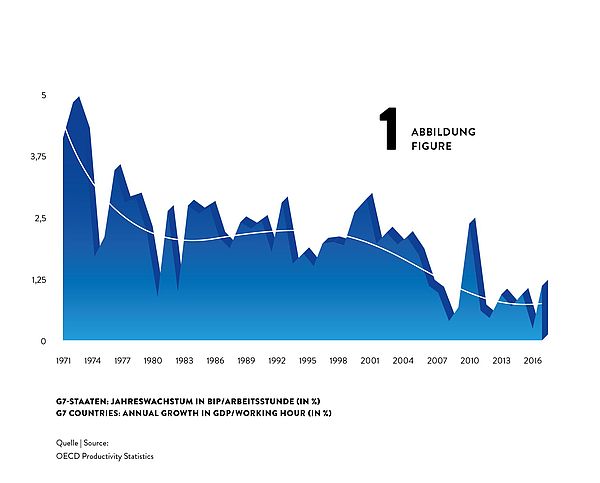
This implies a dramatic loss in potential income: Would the 4% productivity growth have been sustained over the four and a half decades from 1972 to 2017, G7 countries’ GDP per hour would now be unimaginable 2.5 times as high as it actually is. What a potential to, for instance, reduce poverty or to fund research on fundamentals topics as curing cancer or using fusion power!
So why has productivity growth declined dramatically although at the same time we see, for instance, a boom in new digital technologies that can be expected to increase productivity growth? For sure, part of the decline might be spurious and caused by mismeasurement of the contributions of digital technologies. For instance, it is inherently difficult to measure the value of a google search or another video on youtube. That being said, most observers agree that part of the slowdown is real.
Techno-Pessimists and Techno-Optimists
Techno-pessimists say, well, these new technologies are just not as consequential for productivity as, for instance, electrification or combustion engines have been. Techno-optimists argue that it can take many years until productivity effects of new technologies kick in, and it can come in multiple waves. New technology we have now may just be the tools to invent even more consequential innovations in the future.
While this strand of the discussion is concerned with the type of technology invented, others see the problem in that inventions nowadays may diffuse slowly from technological leaders to laggards creating a wedge between few superstar firms and the crowd (Akcigit et al., 2021). Increased market concentration and market power by superstar firms may reduce competitive pressure and the incentives to innovate.
Finally, reduced Schumpeterian business dynamism, i.e. a reduction in firm entry and exit as well as firm growth and decline, reflects a slowdown in the speed with which production factors are recombined to find their most productive match.
While the explanation for and the way out of the productivity puzzle are still unknown, it seems understood that using granular firm level data is the most promising path to find answers.
What are the Origins of Productivity Growth?
Aggregate productivity growth can originate from (i) a more efficient use of available inputs at the firm level as described above or (ii) from an improved allocation of resources between firms.
Higher efficiency at the firm level captures, e.g., the impact of innovations (Acemoglu et al., 2018) or improved firm organisation (management) (Heinz et al., 2020; Müller und Stegmaier, 2017), while improved factor allocation describes the degree of which scarce input factors are re-allocated from inefficient to efficient firms (‘Schumpeterian creative destruction’) (Aghion et al., 2015; Decker et al., 2021).
Most economic processes influence the productivity of existing firms and the growth and the use of resources of these firms and their competitors as well. The accelerated implementation of robotics in German plants (Deng et al., 2020), the foreign trade shocks induced by the rise of the Chinese economy (Bräuer et al., 2019), but also the COVID-19 pandemic, whose consequences are still to evaluate (Müller, 2021) not only effects on productivity and growth of the firms directly affected but at the same time may create new businesses and question existing firms.
While productivity can be measured at the level of aggregated sectors or economies, micro data on the level of individual firms or establishments are indispensable to study firm organisation, technology and innovation diffusion, superstar firms, market power, factor allocation and Schumpeterian business dynamism. The IWH adopts this micro approach within the EU Horizon 2020 project MICROPROD as well as with the CompNet research network.
As “creative destruction” may also negatively affect the persons involved (e. g., in the case of layoffs, Fackler et al., 2021), the IWH analyses the consequences of bankruptcies in its Bankruptcy Research Unit and looks at the implications of creative destruction for the society, e. g., within a project funded by Volkswagen Foundation searching for the economic origins of populism and in the framework of the Institute for Research on Social Cohesion.
Publications on “Productivity”
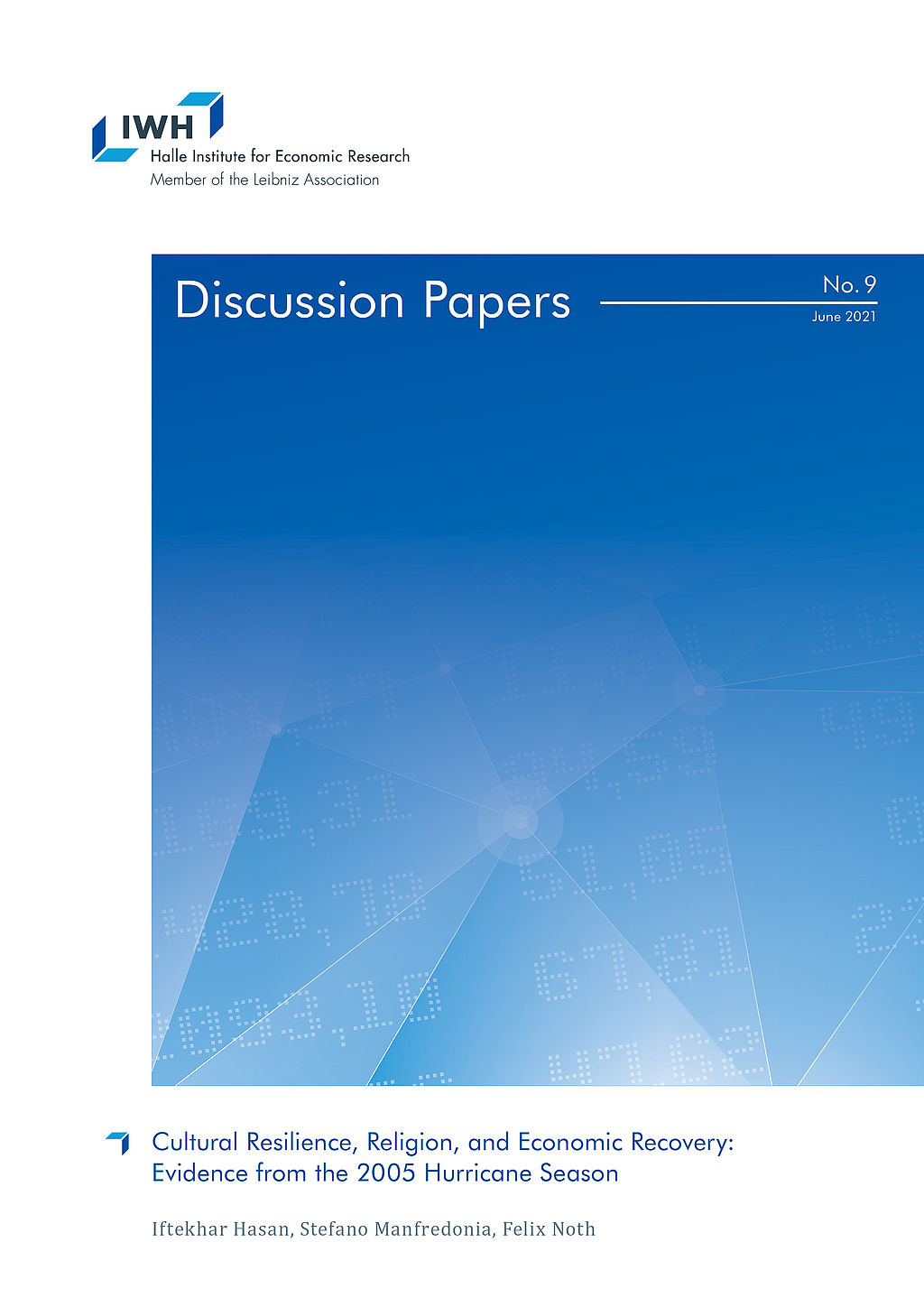
Cultural Resilience, Religion, and Economic Recovery: Evidence from the 2005 Hurricane Season
in: IWH Discussion Papers, No. 9, 2021
Abstract
This paper investigates the critical role of religion in the economic recovery after high-impact natural disasters. Exploiting the 2005 hurricane season in the southeast United States, we document that establishments in counties with higher religious adherence rates saw a significantly stronger recovery in terms of productivity for 2005-2010. Our results further suggest that a particular religious denomination does not drive the effect. We observe that different aspects of religion, such as adherence, shared experiences from ancestors, and institutionalised features, all drive the effect on recovery. Our results matter since they underline the importance of cultural characteristics like religion during and after economic crises.

Productivity and Employment in APAC Economies: A Comparison With the EU Using Firm-Level Information
in: ADBI Working Paper, No. 1264, 2021
Abstract
We provide an overview of productivity development and other related indicators in Asia and Pacific (APAC) countries, with comparisons with the Europe region. We use the seventh vintage firm-level data from the Productivity Research Network in the APAC region and CompNet in Europe for our study. The overall results show that the productivity growth in developed APAC countries (Australia, New Zealand, and the Republic of Korea) is significantly ahead of the growth in developing APAC countries (India and the People’s Republic of China) and on par with the EU’s growth. There is an ongoing process of bottom firms catching up with top firms in the Republic of Korea and the richest EU countries. Regarding employment and labor skills, employment growth has generally been quite stagnant in all regions. Labor skills, for which we use the wage premium as a proxy, are quite similar across most regions, with the richest EU countries showing a higher premium than the rest. Our test of the productivity–employment link indicates that the size of employment tends to have a greater impact on productivity in APAC countries, while labor skills have greater emphasis in the EU.
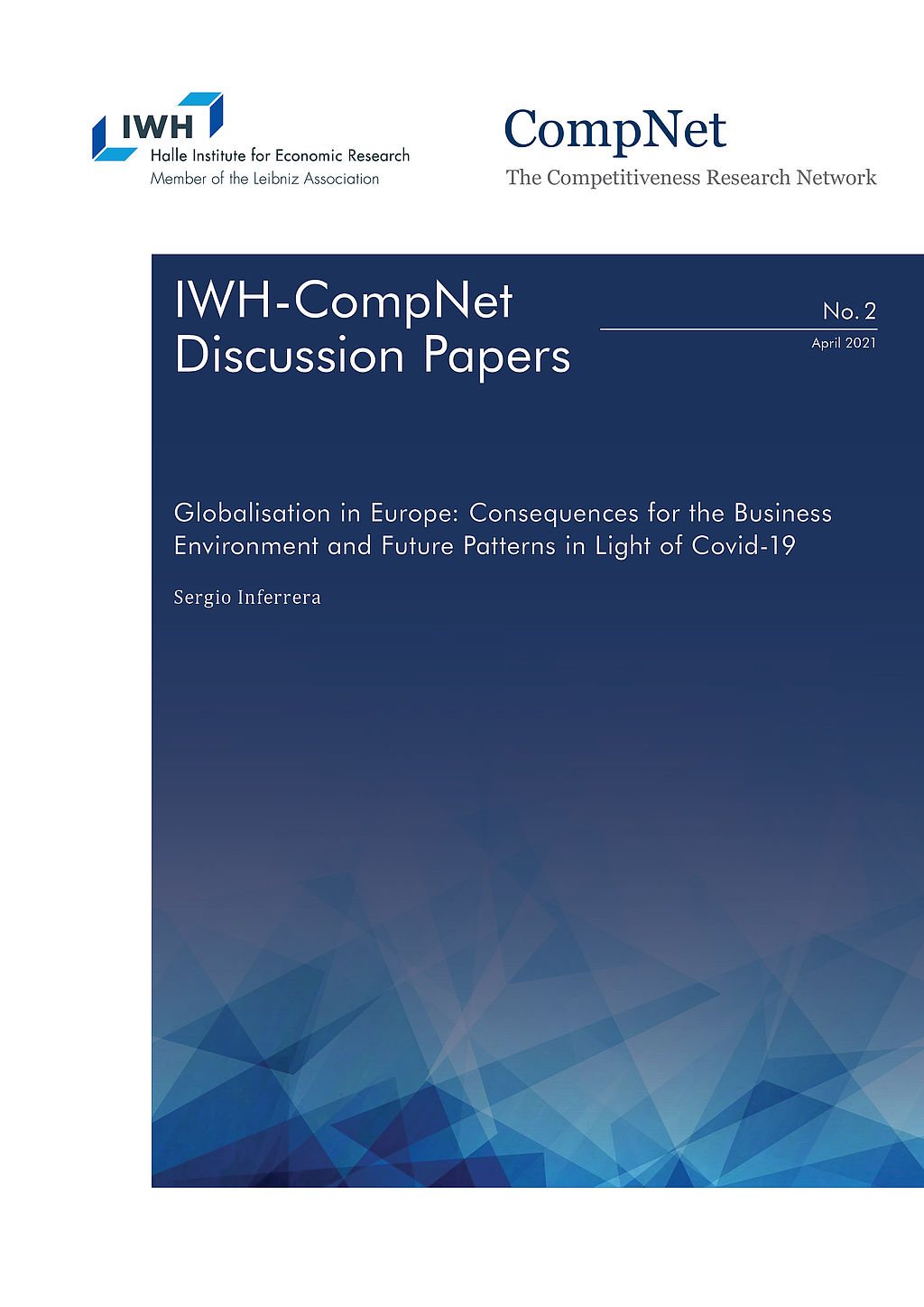
Globalisation in Europe: Consequences for the Business Environment and Future Patterns in Light of Covid-19
in: IWH-CompNet Discussion Papers, No. 2, 2021
Abstract
In this paper, I study the consequences of globalisation, as measured by the involvement of firms in GVC, on the business environment. In particular, I focus on concentration and productivity, firstly by estimating robust elasticities and then isolating the exogenous component of the variation in the participation in GVC. To this aim, I exploit the distance between industries in terms of upstreamness and downstreamness along the supply chain. The evidences suggest that involvement in international supply chains is positively related to concentration at the sector level and positively associated with aggregate productivity, an effect that is driven by the firms at the top of the productivity distribution. Finally, I relate these findings to the current pandemic, going beyond the lack of official statistics and estimating GVC participation for 2020 at the country-level through real time world-seaborne trade data, providing evidences on the re-absorption of the Covid shock in several European economies.
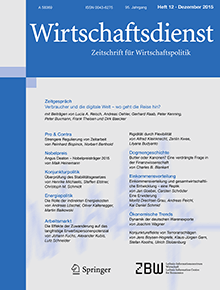
The East-West-German Productivity Gap: Lessons from Firm-level Data?
in: Wirtschaftsdienst, No. 13, Konferenzband "30 Jahre Deutsche Einheit", März 2021
Abstract
According to national accounts, the East German economy is at only 80 % of West German labour productivity even 30 years after the fall of the Iron Curtain. This difference in aggregate labour productivity goes hand in hand with many of the economic and societal problems East Germany faces today. To understand the sources of the aggregate productivity gap, this study discusses recent literature on the East-West gap that applies granular firm and product level data. The evidence clearly shows the relevance of firm-level productivity differences for the aggregate gap and challenges common hypotheses derived from aggregate data.
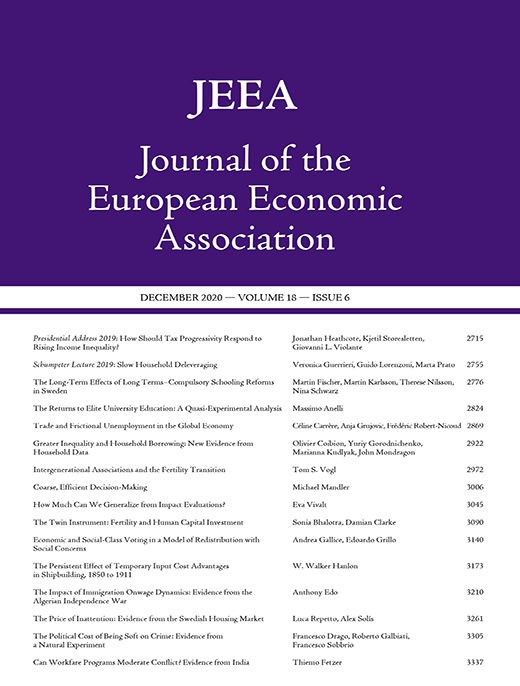
International Emigrant Selection on Occupational Skills
in: Journal of the European Economic Association, No. 2, 2021
Abstract
We present the first evidence on the role of occupational choices and acquired skills for migrant selection. Combining novel data from a representative Mexican task survey with rich individual-level worker data, we find that Mexican migrants to the United States have higher manual skills and lower cognitive skills than nonmigrants. Results hold within narrowly defined region–industry–occupation cells and for all education levels. Consistent with a Roy/Borjas-type selection model, differential returns to occupational skills between the United States and Mexico explain the selection pattern. Occupational skills are more important to capture the economic motives for migration than previously used worker characteristics.



